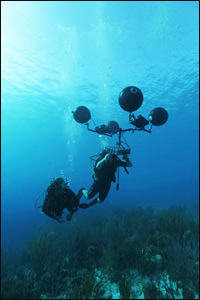Ocean Electronics
 A technology facilitator for Multi
A technology facilitator for MultiDisciplinary Oceanographic Application
Development of regularization schemes for performance improvement of underwater target classifiers
Underwater target classification has been a thrust area of research due to its commercial as well as strategic importance. Two high performance classifiers namely the hierarchical target trimming classifier and Hidden Markov Model classifier have been implemented and tested successfully. The performance of these classifiers may be fine-tuned taking into consideration the underwater acoustic channel degrading phenomena. The implementation of such degrading factors like Doppler effect, scattering, Multipath Rayleigh fading, reverberation, formation of shadow zones, absorption etc., into the learning models have been initiated.
Along with these, a parsimonious model for the target data, requiring a number of parameters much smaller than its original dimension needs to be formulated taking into account the large dimensionality and computational complexity. A data-driven representation of the evidence can be built inorder to determine the selection strategy of measurements that are the most relevant. In this way, an efficient manipulation of this new representation can be done with negligible loss of information since it is assumed that the variables selected carry almost all the relevant information for the classification purpose. In addition, it helps to develop a representation that is interpretable. Hence, appropriate regularization schemes that can yield sparse solutions need to be developed and the consistency properties of the obtained estimator need to be studied both in terms of prediction as well as selection performance.

High performance Parallel Implementation of Hidden Markov Models with CUDA Architecture
Graphic Processor Units (GPUs) are high performance processors, conventionally used for rendering high graphic multimedia contents for memory intensive applications. However, recent researches in the parallel processing paradigm have led to the new innovative concept where application specific GPUs could be used for processing arbitrary data while not just limiting them to graphical rendering. One such implementation, CUDA or Compute Unified Device Architecture Cores, introduced by NVIDIA group for their graphical processors can ease the development of parallel and highly computationally expensive algorithms, like HMM. So the GPU architecture can be used to reduce their computational complexity by providing methods to parallelize computation thereby speeding up the algorithms already implemented.
Some HMM algorithms that can be taken into consideration are the Forward Algorithm, Viterbi Algorithm and Baum-Welch Algorithm. The parallelization of these algorithms needs to be done with the understanding of the GPU process. Comparison between typical algorithm implementation and a parallelized version can be implemented to establish the efficacy of the GPGPU-HMM.
Multiple Target Tracking using Dynamic Programming
 Tracking multiple targets in a high cluttered environment where multiple receivers are used is a challenging task due to the high level of false alarms and uncertainty in the tracking hypothesis. Due to the nature of the underwater environment and sound propagation characteristics, tracking targets in the underwater environment becomes a complex operation. Conventional tracking approaches (such as the Kalman and particle filter) require a predetermined kinematic model of the target. Moreover, tracking an unknown and changing number of targets within a certain search area requires complex mathematical association filters to identify the number of targets and associate measurements to different target tracks. As the number of false detections increases, the computational complexity of conventional tracking system grows introducing further challenges for real-time target tracking situations.
Dynamic programming approach in multi-target tracking could be more explicitly called a solution strategy rather than an algorithm, and employs a staged optimization policy for solution development.
Tracking multiple targets in a high cluttered environment where multiple receivers are used is a challenging task due to the high level of false alarms and uncertainty in the tracking hypothesis. Due to the nature of the underwater environment and sound propagation characteristics, tracking targets in the underwater environment becomes a complex operation. Conventional tracking approaches (such as the Kalman and particle filter) require a predetermined kinematic model of the target. Moreover, tracking an unknown and changing number of targets within a certain search area requires complex mathematical association filters to identify the number of targets and associate measurements to different target tracks. As the number of false detections increases, the computational complexity of conventional tracking system grows introducing further challenges for real-time target tracking situations.
Dynamic programming approach in multi-target tracking could be more explicitly called a solution strategy rather than an algorithm, and employs a staged optimization policy for solution development.
This research will examine the benefits of applying a tracking algorithm based on Dynamic Programming for multiple target tracking. Utilizing dynamic programming as the major block in the tracking algorithm along with other auxiliary artificial intelligence techniques can facilitate breaking down the multiple targets tracking problem to simpler hierarchical set of steps. It is hypothesized that by applying an efficient dynamic programming algorithm with sufficient data reduction, the tracking problem would require less complexity and an effective multi-target tracking system can be applied when multistatic active sonobuoy fields are deployed.